A decade after the crash, Shannon Valley housing estate, on the outskirts of Ballaghaderreen, in Co Roscommon, remains unfinished and partly in ruins. Although the number of “unfinished housing developments” has fallen sharply since 2010, Shannon Valley is one of hundreds that still dot the country.
The Guls: ‘Every day I put rats in the bin’
Fatima Gul says her little brother, Yousaf, doesn’t like the rats. He jumps up on the sofa or the table in the living room when they come into the house. Their parents don’t allow Fatimar, who is 10, or her nine-year-old sister, Maryam, or Yousaf and his twin, Zohra, who are five, to play near the houses on the other side of their green. It’s too close to the rats and the rubble.
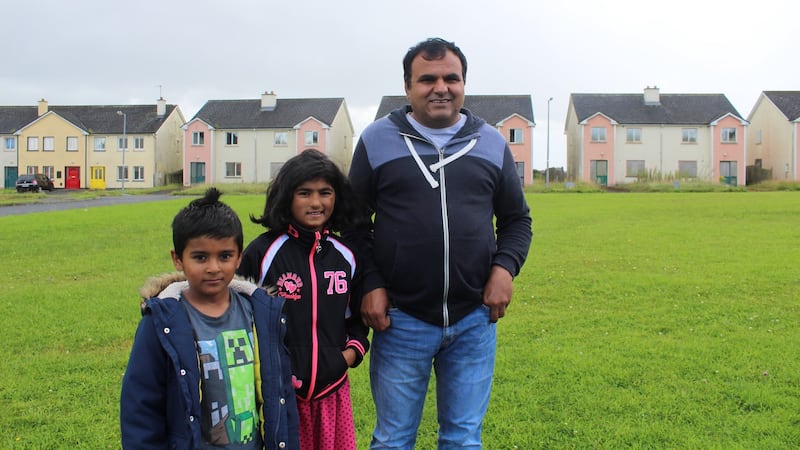
It is like two estates. The Gul family, originally from Pakistan and living in Ireland for that lost economic decade, and their immediate neighbours live in well-kept terraced homes. Most of the houses surrounding them on three sides resemble a war zone.
Shannon Valley is one of the country’s remaining 420 ghost estates that the Department of Housing lists as an “unfinished housing development” but it is one of the worst. It still haunts its residents. There are 38 houses in the estate; 23 are unoccupied and in various states of disrepair and dereliction.
A single street light standing in a neighbouring, fenced field is all that remains of the final phase of 20 houses that were demolished in 2014 with a “special resolution fund” of €250,000 from the Government.
I just want the houses to go away because there are rats and I want the estate to be clean
This money has been nowhere near enough for an estate that still poses serious health and safety issues, has serious anti-social behaviour and affects the day-to-day lives of its residents.
“I just want the houses to go away because there are rats and I want the estate to be clean,” says Maryam, standing next to her big sister Fatima.
Their mother, Shadab, says she tries to keep an eye on her children when they are playing out front. She is afraid that the children will pick up an infection from the vermin. Last year they had an infestation of rats from the derelict houses which were drawn to the smell of food. She put traps down in the house most days.
“Every day I put one or two in the bin. It was very bad,” she says.
The Ryans: ‘It could have been a good estate’
Life in Shannon Valley requires constant vigilance. The estate is a monument to the hubris that gripped the country’s builders and bankers, planners and politicians during the Celtic Tiger era; an unofficial memorial to over-development, reckless lending and the failure of government policy to protect its people in a time of excess.
The fronts of the houses in the worst condition are boarded up. Some have broken windows. Around the back the full horror of a forgotten estate can be seen. There are no fences or boards blocking off access to the properties at the back. Drain holes and sewage pipes have been left uncovered. Glass from windows and patio doors lie shattered on the ground; fridges have been ripped out of units and wooden-frame couches have been broken up.
In one house, unopened letters about water charges and the area’s new Eircode are gathering dust beneath a letter box filled with cobwebs. Next to them is a dirty nappy and a single leather shoe.
Among the detritus in the living room are empty beer cans and a pair of women’s underwear. Plug sockets, radiators and copper pipes have been ripped from walls. Anything valuable in the house has been removed.
“I have no sympathy for the landlords. They brought it on themselves. Good enough for them,” says Connor Ryan, standing in the half-built house, looking over to his own home across the green.
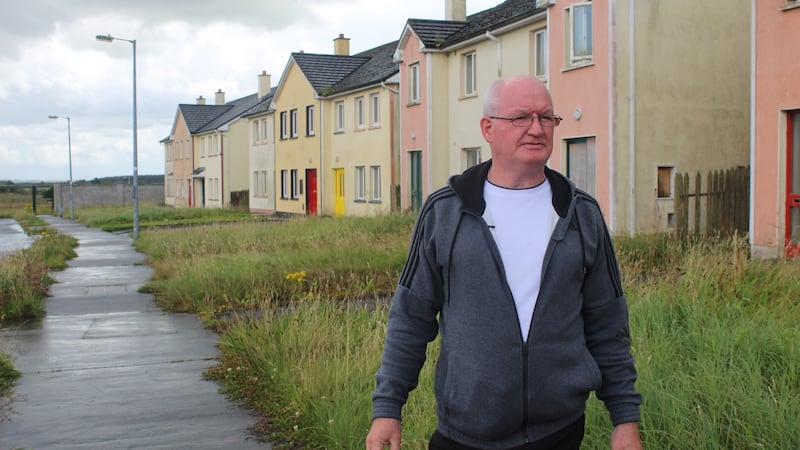
Ryan and his wife, Esther, bought their house off the plans in 2005 with savings of €145,000 and no mortgage. They had been living in London since the early 1990s and wanted to move back to Ireland. They saw the houses at Shannon Valley advertised for sale in Irish community newspapers in London and jumped at the opportunity.
“We never done our research. We were told that they would be sold to families and that the families would be able to move in. Instead they were sold to private landlords. Landlords buying them to rent them is what actually killed the whole estate,” he says.
Ryan has no idea if the unfinished houses are owned by the estate’s original developer, Brendan Carney, whose Co Sligo-based company BMC Developments built them, or by ACC Bank, the late-to-the-party Dutch-owned lender that financed this and other housing estates in rural Ireland, or the banks that loaned money to buy-to-let investors to make money renting them out.
It is a pity because it could have been a good housing estate but the landlords who own the houses got too greedy
(Carney did not respond to a request for comment made through his solicitor.)
“It is a pity because it could have been a good housing estate but the landlords who own the houses got too greedy,” he says.
“The proper thing to do is to knock them all down and compensate all the people who bought houses here.”
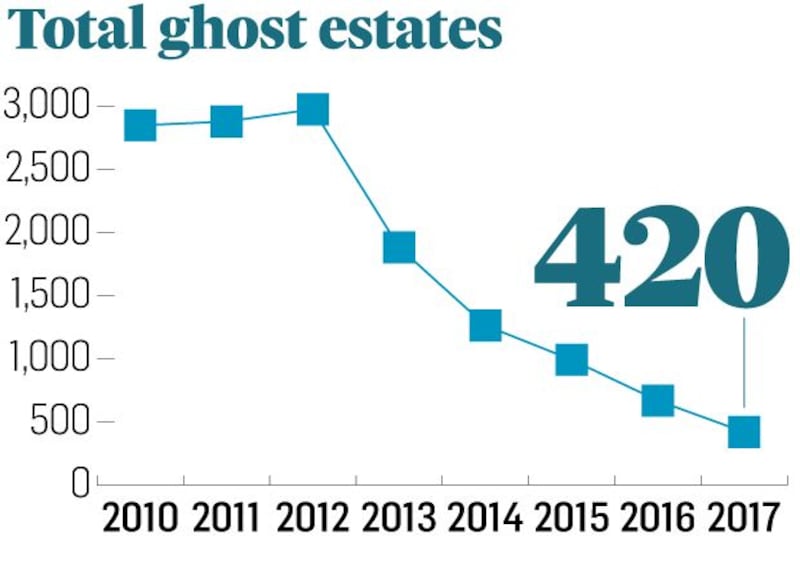
Dave Hand: ‘You pull the curtains and stay inside’
Ryan’s neighbour Dave Hand praises Connor for his work in trying to save the estate. Hand says that Ryan and his wife could not leave their home unattended for years because of the high risk of burglary on the estate. Shannon Valley would still be in darkness at night if it was not for Ryan pushing the council to install street lighting, he says.
“I’m right on the front line of it,” says the Dubliner, pointing to his nicely decorated home next to a house boarded up with sheets of metal.
“It is lovely when you go inside and pull the curtains but it’s awful when you have to look out at what is going on around.”
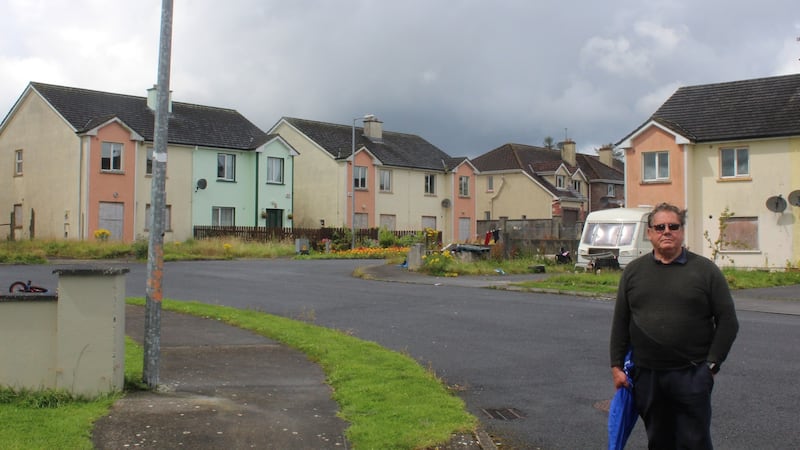
For years, Hand, who is now retired from An Post, travelled from Dublin to his Roscommon home on Friday evenings for weekends. While in Dublin his house was broken into so many times that he used to leave the back window open so that he would not have to pay repeatedly for its repair. Among the items stolen were his satellite dish, the burner in his oil tank and even the oil in the tank.
“It was dreadful not knowing what you were going to find when you opened the doors,” he says.
He bought the house off plans for €165,000, all with his own money. He estimates that it is worth between €40,000 and €50,000 now. The Property Price Register shows that just five houses have sold in the estate in the past four years, ranging in price from €17,000 in December 2013 to €40,000 in July 2016.
Hand laughs when asked whether he regrets buying here.
It's f**king desperate here. The shouting and roaring. It's not only what's in here. It's what they draw and who comes in to visit them
“Yeah, €165,000. I would get three bungalows out the road for that and I would have peace and quiet,” he says.
“It’s f**king desperate here. The shouting and roaring. It’s not only what’s in here. It’s what they draw and who comes in to visit them. It is like no man’s land. You just mind your own business. You pull the curtains and stay inside.”
Keeping a big dog as a pet helps keep trouble at bay, he says.
“I don’t have any kids,” he says. “I pity anyone who is trying to rear kids here. It must be terrible because all you get is abuse. Desperate.”

The politician: ‘There were far too many built’
Down the road in Roscommon town, planning file “PD03/571” on Shannon Valley at the county council’s offices reads like a long, unending tale of misery. At the beginning is the planning application for 80 houses and initial discussions between developer and council over individual sites valued at €30,000.
Then there are records showing the appointment of a receiver and reports of house break-ins, children playing “under an unstable bank of sand” and warnings about bricks: “!!! Collapsed or collapse imminent !!!”
There are five ghost estates listed in Ballaghaderreen, that received planning between 2002 and 2004 for almost 200 homes. All that in a town with a population (in decline) of 2,651 in 2016.
Maura Hopkins, a local resident and Fine Gael senator who is the party’s Seanad spokeswoman on Arts, Heritage and Regional, Rural and Gaeltacht Development, says Shannon Valley is “particularly difficult” to resolve.

The €250,000 allocated last year went to nine unfinished estates across the county but Hopkins notes that the standard of building completed means that it will take large investment to bring the roads, sewerage systems and lighting to a standard where they can be “taken-in-charge” by the council.
“The problems we are trying to work through should never have arisen. We need to rewind back to the Celtic Tiger era if we are going to find the real truth to find out if Roscommon has more problems than other counties. There were far too many developments built and not to an acceptable standard,” she says.
A tax-driven building boom
The Department of Housing’s “Resolving Unfinished Housing Developments” report published in March showed that the Upper Shannon region – Counties Longford, Roscommon, Leitrim and Cavan – along with Co Laois had the most remaining ghost estates, as a proportion of the number of households. (Laois had the most, with eight vacant units per 1,000 households.)
Co Cork had the most number of ghost estates with 56, followed by Co Kerry with 31, Co Tipperary with 30, Co Roscommon and Co Donegal with 28 each, and Co Cavan and Co Leitrim with 21 each.
The high concentration of the estates in the Roscommon-Longford-Leitrim area – and among the hardest to address – can be traced back to the decision of Fianna Fáil minister for finance Charlie McCreevy to grant lucrative tax breaks under the Upper Shannon rural renewal scheme in 1998. The scheme was extended for two more years by his successor in the department, Brian Cowen, in 2006.
The scheme continued even after Goodbody Economic Consultants warned in a February 2006 report that it amounted to poor value for money as the tax cost per housing unit was very high, had little direct impact on economic activity and resulted in an excess supply of housing in the region.
Economist and Longford native Gerard Brady, head of tax and fiscal policy at employers’ group Ibec, called the scheme “an unadulterated disaster” for the region. He estimates that it cost the taxpayer €400 million in lost revenue due to tax breaks and led to about 11,000 housing units being built over the scheme’s 10-year duration (1998 to 2008), including 4,500 buy-to-let properties, in an area with a population of just 250,000.
The Revenue Commissioners could not provide the exact cost of the Upper Shannon tax break scheme in lost revenue.
But the scheme was mouth-watering from a tax-avoidance perspective: the value of the tax break was worth 15-20 per cent of the total cost of building the house, including the value of the land.
There were things built that should not have been built
Department of Housing’s statistics on new house construction show the frenzy of activity that these kind of breaks spawned. There was more house-building in Counties Roscommon, Leitrim and Longford combined than in each of Limerick, Galway and Waterford at the peak of the boom in 2005 and 2006.
Brady estimates that based on the department’s figures there were more houses built in the Upper Shannon counties between 2001 and 2007 than had been built there in the preceding 30 years and that in 2006 and 2007 there were 30 per cent more houses built in Longford than in Cork city and 40 per cent more than in Galway.
“There were things built that should not have been built,” says Brady.
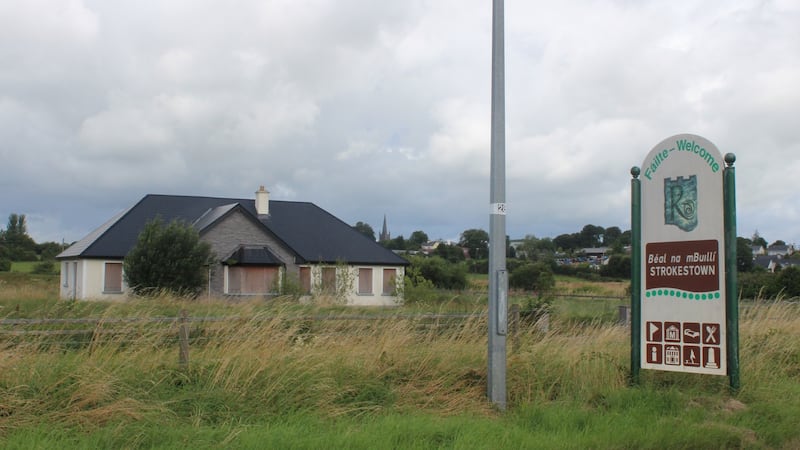
The tax-driven building boom scarred the local economy long term too as manufacturers were “crowded out” with low-skilled workers being sucked into construction, he says. He estimates that one-in-three private-sector workers in Longford and Roscommon were working in construction where the average in most rural counties was 20 per cent.
“The scheme made things worse, both in that it left ghost estates but it also crowded out the real business economy – the exporting and manufacturing economy – and it created a lost decade,” he says.
A developer behind one of Ballaghaderreen’s ghost estates – River Oaks, a development that had planning for 66 houses – acknowledges that the estates were all driven by the tax relief on offer from the government.
“Whatever you write about one would be the same about them all,” says Tuam-based developer Kieran Farrell. “It was all about tax incentives rather than the market requirements. Everything in that area was all built around tax incentives.”
A reminder of what not to do
Now, the challenge for the Government is to find a use for developments in areas where there is low demand for housing or to demolish estates where there is no demand and where there never will be. The most problematic estates are those like Shannon Valley where there are residents in place, where the local authority is not in charge of the estate and where ownership of half-built houses is split between various parties, including banks and landlords.
Within the 420 ghost estates, there are 8,651 dwellings that are complete and occupied; 1,121 are complete and vacant; 4,987 units are in various stages of completion; and 10,075 units have not been started
The department’s March report showed that the number of unfinished developments had fallen to 420 from 2,846 in 2010, a reduction of 85 per cent in six years. Of the remaining estates, 129 developments, or 31 per cent, are empty with no residents. Some 291 developments are home to residents.
Within the 420 ghost estates, there are 8,651 dwellings that are complete and occupied; 1,121 are complete and vacant; 4,987 units are in various stages of completion; and 10,075 units have not been started.
Local authorities received €6 million in completion bonds held by banks and insurers to fund roads, water services, public lighting and other amenities on ghost estates in 2016, part of €63 million paid out in the past seven years.
The State’s National Asset Management Agency (Nama) said it had reduced its exposure to ghost estates from 332 in 2010 to just 11 in March of this year. There are five estates in Cork, three in Wicklow and one each in Dublin, Galway and Donegal on Nama’s books.
Contrary to popular belief, domestic banks such as Bank of Ireland, Allied Irish Banks and Anglo Irish Bank that transferred loans to Nama did not finance as many ghost estates as the foreign-owned banks including ACC, Bank of Scotland (Ireland), Ulster Bank and National Irish Bank.
“There could be a line from Derry to Kerry and everything west of it, outside a city, would get demolished. The market is going to dictate which ones get finished and which ones don’t. It is fairly straightforward,” says Lorcan Sirr, a lecturer in housing studies at Dublin Institute of Technology.
“It costs a lot of money to finish out some of these estates, particularly ones that have been lying idle for a long time, so unless there is market there – whereby whoever finishes them can sell them for more money than they spent bringing them to the market – they are just not going to happen.”
That whole scheme that allowed those ghost estates to happen was initiated with no evidence, only lobbying
Sirr suggests a novel use for some estates as a lesson to “evidence-free policy” pursued by government during the boom times: “Maybe it is no harm to leave one or two standing as a reminder of what not to do.
“There was no evidence there at all that this would be of any benefit. There was no cost benefit done as to what the impact this would have, and anybody could have told the minister, had he the nous to ask about what this would lead to,” he says.
“That whole scheme that allowed those ghost estates to happen was initiated with no evidence, only lobbying.”
Shane Lynskey: ‘I would drive a bulldozer through it’
A 30-minute drive east of Ballaghaderreen is Lisroyne Court, an estate of 16 finished, boarded-up houses, many with smashed windows, just off the main street in the neatly designed village of Strokestown, Co Roscommon. The Property Price Register shows that 10 houses on the estate were sold last year for €275,000.
“You wouldn’t buy much in Foxrock for that,” says Shane Lynskey, a member of the Strokestown Community Development Association, sitting in the lobby of the Percy French Hotel in the town.

The small cul de sac of derelict houses is one of two ghost estates in this tiny town. It is used solely as a short-cut to the main street of the village by children and other residents of a nearby estate. Along that main street are plenty of vacant buildings, pointing to the challenges of squeezing any future economic value out of Lisroyne Court.
“It is an eye sore there, a blight on the landscape. It should never have been built in the first place,” says Lynskey. “I would drive a bulldozer through it and demolish it but that is only me.”
Lynskey’s colleague Emmett Corcoran, a Roscommon communications consultant, says the large amount of poor quality stock in the ghost estates is suppressing the price of houses generally in the area and discouraging people from taking on additional debt by building new houses because they cost more.
“The ghost estates are a hangover from the boom that is impeding this area getting anything like a construction industry back in the region,” he says.
The ghost-estate effect on this area was borne out in a house price report last month by property website Daft.ie, which found that the cheapest place to buy a property was Ballaghaderreen, home to Shannon Valley. The average property value in the town was just €58,000, according to Daft.
“That comes not just from the distance to jobs but the distance to jobs coupled with over-development,” says the author of the report, Ronan Lyons, Trinity College Dublin economist.
Lyons says the government’s Upper Shannon tax relief scheme that blighted the region was a classic example of politicians kidding themselves that people could combine urban working with rural living.
“Ireland is going the way of other high-income countries: to earn a high wage you need to be living in densely populated cities. We have this sort of weird phenomenon where we have one-third of people living in the cities formally but two-thirds working in the city so we have got this middle third,” he says.
“That is not an efficient or environmentally friendly way to do it but it is reflective of this mindset: ‘Well, we don’t need to live in the city; we can live rurally and still enjoy that high income way of life.’ I don’t think that is true. You need to have density to have good quality services.”
Lyons does not envisage a blanket solution to the remaining unfinished estates. He sees demand for some coming from the renters or social housing, not owner-occupiers. Corcoran suggest this avenue too: he points to the 71 people seeking social housing in Strokestown and 69 in Ballaghaderreen, though he acknowledges that local authorities would be reluctant to create “ghettos” out of ghost estates.
“It was always going to be the case that the ones closest to employment were going to be the ones that were going to be developed first after the music stopped in 2009,” says Lyons.
As a sign of the resurgence in the Dublin property market, south Dublin was the only local authority area in the country with no ghost estates, down from 19 in 2013, according to the department’s March report.
The planner: ‘Less than 100 units were demolished’
South of Roscommon, Longford has had greater success within the Upper Shannon region in exorcising its ghost estates. The department’s recent report lists just 11 unfinished estates in the county.
Terry Rooney, a senior executive in the council’s planning and regeneration department, says that out of 128 estates in 2010, more than 80 have been formally completed. These were taken charge of by the council, he says, and “site resolution plans” are in place for the remainder, with the exception of some including Leader Park in Longford town.

The death of the original developer has complicated matters for residents of that estate.
“Back in 2010 there was talk that there would be hundreds of houses knocked that would never be finished, but less than 100 units were actually demolished. What we are finding now is that the houses are being bought because the market is picking up,” says Rooney.
According to the 2016 Census, Longford recorded the largest fall in vacant homes, dropping from 96 vacant homes per 1,000 population in 2011 to 69 in last year. The Upper Shannon region had the worst vacancy rates; towns in Roscommon, Leitrim and Cavan made up six of the seven towns with the highest vacancy rates in 2016.
In Leader Park, local resident Jody McGowan has, like many others who live in unfinished estates, a rat problem. Next to a fenced-off, unfinished apartment is a gated enclosure for household rubbish. The enclosure has no roof so illegal dumping is a problem and it has brought vermin into the estate.
“That is like bloody uranium – it is dangerous,” he says, pointing to an enclosure with “Bin Shed” on it. “It is an environmental hazard. You don’t know what’s in it.”
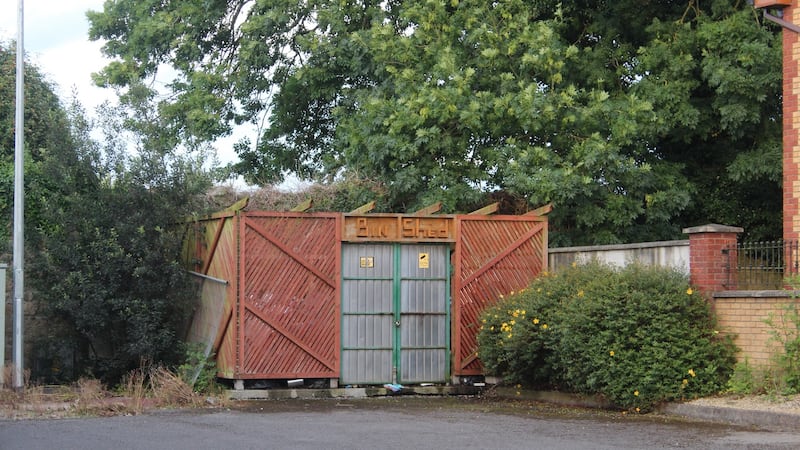
McGowan says the council won’t take charge of the estate until the second layer of tarmacadam has been laid on the roads. Raised man-hole covers are a sign of the job still to be done.
In the meantime, McGowan and other residents have organised lawn-cutting and lobbied the council to have street lighting installed, at a cost of €50 a year for every household.
For him, the four-legged creatures are a bigger problem.
“The last thing you want is a whole housing estate full of rats,” he says.
The academic: ‘Work on these estates is unlikely’
Ghost estates like Leader Park and Shannon Valley – falling between the “completed” and “should be condemned” categories – will be the trickiest ones to solve. The developments where properties have been standing for a decade are weather beaten and exposed, and concrete foundations are difficult to remove.
Rob Kitchin, a researcher at Maynooth University who has written extensively about ghost estates, says there are so many unfinished estates in rural Ireland due to the Government’s “minimal policy, minimal finance approach”.
Rather than compel developers or bankers or local authorities to take on the estates, they have relied on site resolution plans – voluntary, non-mandatory agreements – to “patch up the worst problems of an estate”.
Initial funds allocated have not been enough and in the absence of significant investment, the Government has relied on market recovery rather than action for a proper resolution to the ghost estates. Kitchin says that deconstruction, rather than demolition, should ultimately take place, but that is not cheap to carry out.
“While there’s a shortage of housing in some parts of the country – mainly Dublin and the other principal cities – these are not the locations of the 420 remaining estates, which are principally in rural areas where housing demand and the property market is weak,” he says.
“We basically have a mismatch between demand and areas of over- and under-supply. It’s unlikely that significant work will take place on many of these estates for quite some time, if ever.”
Peadar O’Callaghan: ‘We have no idea who owns it’
In the small village of Boherbue near Mallow in rural Co Cork, a group of local residents vent their frustration that The Beeches, a ghost estate of 56 completed, half-built and barely built houses, has lain idle for about a decade.

On either side of a cul de sac of 22 finished houses are two later construction phases of the estate that are fenced off to the public. Nature has started to take these back. Beech and sycamore saplings grow on the road into one cul de sac, while in the other ragwort and brambles grow into the open shells of houses and over heaps of broken building materials. Clusters of blackberries sit now where there should have been a bay window and a living room.
All that was built on a number of houses was a concrete foundation and a fireplace.
“A fella came here in a helicopter. He took one look and then we heard he was after buying it and then we heard he was after throwing it,” says Peadar O’Callaghan, chairman of the local community development association.
“We don’t know where we are now. We are in total limbo land. There is no communication with the county council and we have no idea who owns it.”
O’Callaghan describes the estate as “a bit like Germany after the second World War – it is an abomination”.

Few people want to live in the completed part. Many of the houses remain vacant with no furniture inside.
On one front door hangs Circuit Court repossession papers seizing the property on behalf of Ulster Bank which is owed money on a boom-time mortgage drawn in 2006. The legal documents are well worn and date back some time. A solicitor’s letter pinned to the door of the empty house stresses the importance of the owner appearing at a court sitting on the morning of December 9th, 2015.
“There was never, ever logic to building the amount of houses that were built,” says local resident Michael Cronin who warned about excessive building in the village as it was being considered. “There was no sense to building 64 houses when the total number of houses built in the whole village over 200 or 300 years was 130 or 140 houses.”
Across the road from the estate, Joan Walsh’s local shop that she has run for 35 years enjoyed a boom in business when the 40 construction workers at The Beeches dropped into her for sandwiches every lunchtime. The work ended abruptly and the workers left. Since then, like on other ghost estates, Walsh has had a problem with rats.
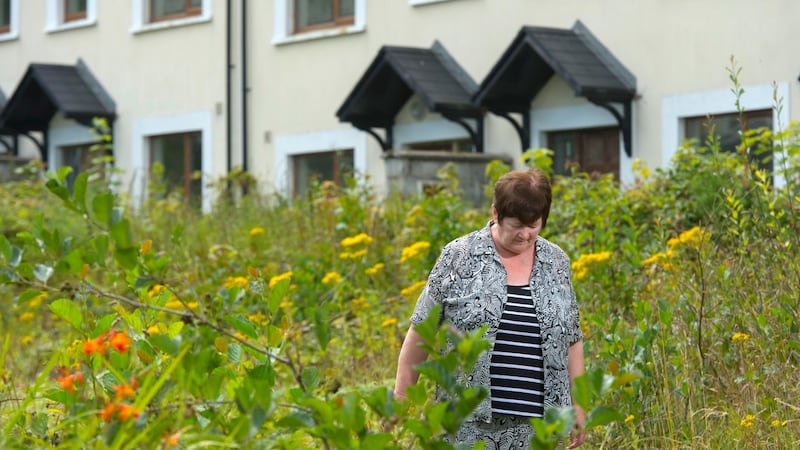
“I am absolutely disgusted,” she says. “They should knock those houses down and put in a bit of greenery and do those houses up and sell them off.”
Fellow residents gathered at the estate on a sunny Wednesday afternoon are angry that the derelict estate continuously surfaces in discussions when the village enters the SuperValu Tidy Towns competition.
Local politician, Fianna Fáil councillor Bernard Moynihan, who lives two miles away from the estate, blames “very poor planning” for the estate.
“You can blame the banks but Cork County Council should never have given them that planning. There was no demand there for that number of houses,” he says.
Moynihan wants the unfinished, third section of The Beeches along with another ghost estate, Lios na Gréine, a 20-minute drive away in the village of Lismire, to be demolished by the council as a dangerous structure under the 1964 Local Government Act. The politician calls the Lismire site as “the worst ghost estate in Co Cork”.
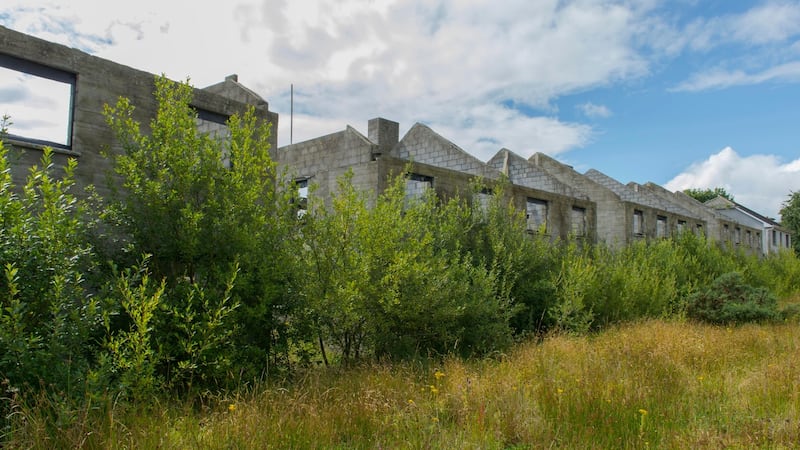
“Lismire is a crossroads with just a school and a church – it was like they were building in Cork city,” he says.
Levelling ‘the bomb site’
At The Beeches, Jim Buckley (76) bought a house in its first phase for €200,000 in 2006, shortly after returning from Chicago where he had worked as an engineer. He estimates that his house is worth about €90,000 today.
“All we want to do is get the job done and to get the ones half-done down. I am told that the council has the money for it but I don’t know what the hold-up is,” he said.
The council told The Irish Times that The Beeches was in the process of being sold and that "the prospective purchaser was amenable to working with Cork County Council to implement a previously agreed site resolution plan".
The original developer, Glen Beg Developments, a company based in Ballincollig, Co Cork owned by builder Sean Power, went into liquidation in 2010 and the council received €335,000 earlier this year on a completion bond. It was unable to say when the completion and demolition works would take place at The Beeches.
The council said Lios na Gréine, built by Millstreet-based Carriganima Construction, was in the hands of a receiver and that “demolition works at the site are outstanding but these are not covered by the bond”.
A battered sign attached to the wall of some of Lismire estate’s completed houses is still advertising “town houses” for sale at €154,000 with “fully serviced sites” on offer at €55,000. A wooden fence blocks the view of the ugliest part of the estate from the windows of the village’s national school across the road.
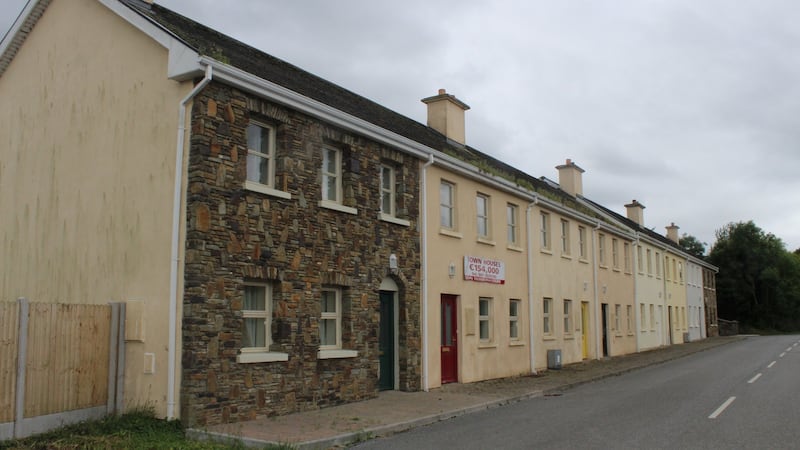
Two elderly women walking by recall being able to see green fields and rolling hills from the school where the fence is now. One remembers the school’s one-time principal talking about how beautiful the view once was.
“‘This is better than the Bahamas,’ he used to say,” she recalls, not wanting to be identified.
One Christmas, she says, the developer landed in his helicopter when Lios na Gréine was being built. It was intended as a thank you to the school children for the disruption caused during the construction.
The disruption has continued for many Christmases since then.
“It was crazy,” she said. “Where were the jobs? Where were the amenities?”
In Boherbue, O’Callaghan says the residents are hoping that the council will fulfil a promise to level “the bomb site” – the worst part of The Beeches – and fix up the second part so the houses can be sold.
“I can’t see anyone local taking this on,” says the chairman of the Boherbue development association. “We are all waiting for another person to come in a helicopter. We are watching the skies.”











